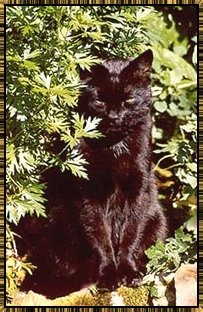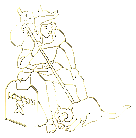

Cats in Fables, Fairytales and Festivals
Articles in Fabled Felines are written by
Patrick Roberts
Copyright © 2003-24 Purr 'n' Fur UK
Certain features on these pages use JavaScript

|
Articles in Fabled Felines are written by Certain features on these pages use JavaScript |
[
Home |
Famous |
Featuring |
Fans |
Fabled |
Folios |
Fun |
Philately |
Fragments |
Flotsam
]
Privacy statement
Dick Whittington and his CatThe myth and the reality |

|
|
Click thumbnails for enlargements (JavaScript should be enabled) This is a cat tale probably without a cat, The myth
One day, Fitzwarren called the servants together to tell them that he had a ship leaving soon for foreign parts with goods to trade, and invited them to send along any of their possessions they wished to sell to make a bit of money. Dick had only his cat to give, and although he loved her dearly and would have to put up with the rats again, he gave her to the captain to sell or trade. Some versions of the story say he parted with his cat at the suggestion of the daughter of the house, Alice, of whom he was fond and whom he wished to please. Life went on for a while for the scullery boy — but without his cat, and with Fitzwarren's cook doing everything she could to make his life miserable, Dick eventually decided London was not for him and he would return home to Gloucestershire. Pausing on Highgate Hill on his way out of London, however, he heard the bells of Bow Church ringing, and they seemed to be saying, 'Turn again, Whittington, thrice lord mayor of London.'
A variation of the tale has the cat returned to Dick, along with his reward from the grateful king: but in any case, Dick had become a wealthy young man. He asked for Alice's hand in marriage, which she accepted, and he set up his own trading business. Eventually he became Mayor of London — three times (or thrice), just as the bells had predicted. * * * * * * * * * * * * * * * The real storyRichard Whittington was an actual person, who lived from about 1350 to 1423. He was the younger son of Sir William Whittington, Lord of the Manor of Pauntley, in Gloucestershire, and as such he was neither poor nor an orphan. However, his elder brother inherited the estate upon Sir William's death in 1358, and Richard did travel to London to find work.
It's correct that Dick Whittington married Alice, daughter of Sir Ivo Fitzwarren of Dorset. In 1393 Dick became an alderman (magistrate) of the City of London; and then when the Mayor, Adam Bamme, died in 1397, the king chose Whittington as his replacement. He was elected again the year after, and twice more, in 1406-7 and 1419-20. Technically, therefore, he served four times as Mayor, although two of the terms were back to back. He was never actually 'Lord' Mayor, as this title was not used until a much later period, but the Mayor was a very important position: the holder was head of government for the City of London. He died in 1423; Alice had died before him and they had no children. In his will Whittington requested that his wealth be used to benefit the city that had made his fortune for him. An almshouse was set up (where poor homeless people could live), in addition to a priests' college, a library, and various public projects including improving London's water supply and rebuilding Newgate Prison, where it is said that there was a carving of a cat over one of the gates (the prison was destroyed in the Great Fire of 1666, and was subsequently rebuilt in its third incarnation, sans cat). Whittington�s charity is still operated today by the Company of Mercers. In 1966 the almshouses were rebuilt outside London, and they home a number of elderly people. The story of Dick Whittington, thrice Mayor of London, has survived over the centuries and still appeals to people, perhaps because of the idea that they also could dream of going to the big city and making their fortune: certainly London remains a magnet for all kinds of people hoping to better their position. And each Christmas season the Whittington story is still re-enacted in pantomime. (You may be interested to see a programme from 1897.) And the cat?
The inscription on the stone reads:
And what was the cat's name? So the tale goes, he (rather than 'she') was called Tommy — that is to say, the tradition in pantomime is that Whittington's cat is always a 'he' and his name is Tommy. Further notes:
3) The county of Shropshire disputes the claims that Dick was a rich man's son from Gloucestershire, and that Fitzwarren was the wealthy merchant in London. The Shropshire village of Whittington has a Welsh border castle, said to have been owned by Sir Ivo Fitzwarren in the 14th century; Alice, whom Dick married, was Sir Ivo's daughter. It is possible that Dick was born in Whittington, and was a peasant lad who went to London to seek his fortune. Whatever the truth, the Mercers' Company made a £5,000 grant to the Whittington Castle Preservation Trust (see also Facebook) to aid in a renovation project. More substantially, the castle trust was awarded nearly a million pounds in May 2005 from a lottery grant and, as a result of that, restoration work began in November 2005. The work included a new tearoom and other improved visitor facilities, and the refurbished site was officially opened in June 2007 by the Duke of Gloucester.
This lovely postal cover has Dick Whittington's picture — and the cat — with a set of GB stamps issued in 1989 showing the Lord Mayor's Show and celebrating 800 years of London mayors. |
|||||||||||||||
If you'd like to comment please contact me,
or drop in at our Facebook page
Return to:
Fabled Felines index
Other sections:
Famous Felines
Featuring Felines
Fans of Felines
Feline Folios
Feline Fun
Feline Philately
Feline Fragments
Feline Flotsam
or visit the Purr 'n' Fur home page

|
Our featured feline at the head of the page: it was with great regret that I decided to let Pushkin be 'put to sleep' early in 2006, following intractable health problems, a gloomy prognosis and a much diminished quality of life. He was a 'rescue cat' of uncertain age, but I would guess 12 years or more. He will be remembered with great affection as a cat with perfect manners: a gentle soul who seemed even more inscrutable than the average feline. There's a small tribute to him here. |
Copyright © Patrick Roberts & Purr 'n' Fur UK 2003-24
All rights reserved
Images and content (whether original or used at Purr 'n' Fur with permission) may NOT be reproduced
at another website or otherwise copied or used without prior permission.
Direct linking (hotlinking) to ANY images on this site is strictly forbidden.
If you want something,
!
Page created May 2005, with later revisions and additions